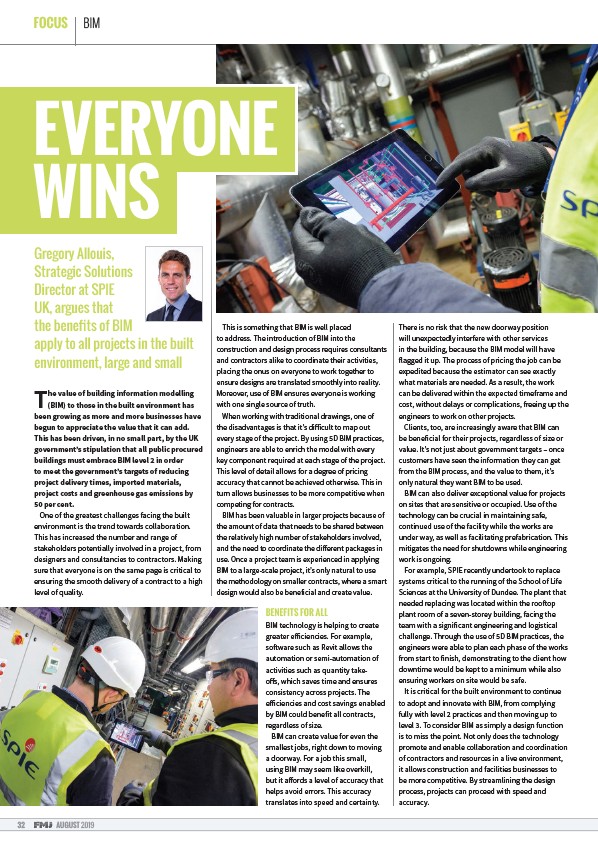
FOCUS BIM
EVERYONE
WINS
The value of building information modelling
(BIM) to those in the built environment has
been growing as more and more businesses have
begun to appreciate the value that it can add.
This has been driven, in no small part, by the UK
government’s stipulation that all public procured
buildings must embrace BIM level 2 in order
to meet the government’s targets of reducing
project delivery times, imported materials,
project costs and greenhouse gas emissions by
50 per cent.
One of the greatest challenges facing the built
environment is the trend towards collaboration.
This has increased the number and range of
stakeholders potentially involved in a project, from
designers and consultancies to contractors. Making
sure that everyone is on the same page is critical to
ensuring the smooth delivery of a contract to a high
level of quality.
32 AUGUST 2019
This is something that BIM is well placed
to address. The introduction of BIM into the
construction and design process requires consultants
and contractors alike to coordinate their activities,
placing the onus on everyone to work together to
ensure designs are translated smoothly into reality.
Moreover, use of BIM ensures everyone is working
with one single source of truth.
When working with traditional drawings, one of
the disadvantages is that it’s di‘ icult to map out
every stage of the project. By using 5D BIM practices,
engineers are able to enrich the model with every
key component required at each stage of the project.
This level of detail allows for a degree of pricing
accuracy that cannot be achieved otherwise. This in
turn allows businesses to be more competitive when
competing for contracts.
BIM has been valuable in larger projects because of
the amount of data that needs to be shared between
the relatively high number of stakeholders involved,
and the need to coordinate the di‘ erent packages in
use. Once a project team is experienced in applying
BIM to a large-scale project, it’s only natural to use
the methodology on smaller contracts, where a smart
design would also be beneficial and create value.
BENEFITS FOR ALL
BIM technology is helping to create
greater e‘ iciencies. For example,
so˜ ware such as Revit allows the
automation or semi-automation of
activities such as quantity takeo
‘ s, which saves time and ensures
consistency across projects. The
e‘ iciencies and cost savings enabled
by BIM could benefit all contracts,
regardless of size.
BIM can create value for even the
smallest jobs, right down to moving
a doorway. For a job this small,
using BIM may seem like overkill,
but it a‘ ords a level of accuracy that
helps avoid errors. This accuracy
translates into speed and certainty.
There is no risk that the new doorway position
will unexpectedly interfere with other services
in the building, because the BIM model will have
flagged it up. The process of pricing the job can be
expedited because the estimator can see exactly
what materials are needed. As a result, the work
can be delivered within the expected timeframe and
cost, without delays or complications, freeing up the
engineers to work on other projects.
Clients, too, are increasingly aware that BIM can
be beneficial for their projects, regardless of size or
value. It’s not just about government targets – once
customers have seen the information they can get
from the BIM process, and the value to them, it’s
only natural they want BIM to be used.
BIM can also deliver exceptional value for projects
on sites that are sensitive or occupied. Use of the
technology can be crucial in maintaining safe,
continued use of the facility while the works are
under way, as well as facilitating prefabrication. This
mitigates the need for shutdowns while engineering
work is ongoing.
For example, SPIE recently undertook to replace
systems critical to the running of the School of Life
Sciences at the University of Dundee. The plant that
needed replacing was located within the roo˜ op
plant room of a seven-storey building, facing the
team with a significant engineering and logistical
challenge. Through the use of 5D BIM practices, the
engineers were able to plan each phase of the works
from start to finish, demonstrating to the client how
downtime would be kept to a minimum while also
ensuring workers on site would be safe.
It is critical for the built environment to continue
to adopt and innovate with BIM, from complying
fully with level 2 practices and then moving up to
level 3. To consider BIM as simply a design function
is to miss the point. Not only does the technology
promote and enable collaboration and coordination
of contractors and resources in a live environment,
it allows construction and facilities businesses to
be more competitive. By streamlining the design
process, projects can proceed with speed and
accuracy.
Gregory Allouis,
Strategic Solutions
Director at SPIE
UK, argues that
the benefi ts of BIM
apply to all projects in the built
environment, large and small